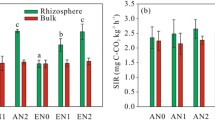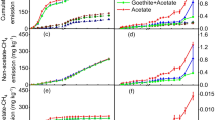Abstract
Methane oxidation rates in the rhizosphere of Pontederia cordata,Sagittaria lancifolia, and Typha latifolia were quantified in fieldstudies using the methyl fluoride inhibition technique. An averageoxidation of 22.9 ± 17.7% (sd,n = 44) was found for all field experiments (oxidation is expressedas a % of total potential emission in the presumedabsence of oxidation). Greenhouse experiments using the same techniquegave an average rhizospheric oxidation of 64.9 ±17.0% (sd, n = 44). Comparison of a subset ofgreenhouse plants with the methyl fluoride (MF) and a light oxic/darkanoxic (LO/DA) technique for suppressing CH4 oxidationyielded similar percentages (57.7 ±15.0% for MF and 58.5 ±13.9% for LO/DA, n = 11). Rhizospheric oxidationdisplayed a seasonal trend in Typha latifolia with decreasingoxidation percentages during warmer months as the importance ofrhizospheric CH4 oxidation declined relative toCH4 emission (46.5 ±13.8% in December and 13.5 ±1.7% in July). However, the absolute rateof methane oxidation was highest during the warmer months (44.2± 3.4 mg m-2 d-1 inDecember and 318.7 ± 151.4 mg m-2d-1 in July). As methane emission rates increased,the sensitivity of the methyl fluoride technique decreased dueto the larger error between replicate flux measurements.
Similar content being viewed by others
References
Armstrong J & Armstrong W (1988) Phragmites australis-A preliminary study of soil oxidizing sites and internal gas transport pathways. New Phytologist 108: 373–382
Bartlett KB, Crill PM, Sass RL, Harriss RC & Dise NB (1992) Methane emissions from tundra environments in the Yukon-Kuskokwim Delta Alaska. J Geophys Res 97: 16645–16660
Bedford BL, Bouldin DR & Beliveau BD (1991) Net oxygen and carbon dioxide balances in solutions bathing roots of wetland plants. J Ecology 77: 943–959
Brix H, Sorrell BK & Orr PT (1992) Internal pressurization and convective gas flow in some emergent freshwater macrophytes. Limnol. Oceanogr. 37: 1420–1433
Budavari S (Ed) (1989) The Merck Index. Merck & Co., Inc., Rathway, NJ
Chanton JP & Dacey JWH (1991) Effects of vegetation on methane flux reservoirs and carbon isotopic composition. In: Sharkey T, Holland E & Mooney H (eds) Trace Gas Emissions from Plants (pp 65–92). Academic Press, San Diego
Chanton JP, Martens CS & Kelley CA (1989) Gas transport from methane-saturated, tidal freshwater and wetland sediments. Limnol Oceanogr 34: 807–819
Chanton JP, Whiting GJ, Showers WJ & Crill PM (1992) Methane flux from Peltandra virginica: stable isotope tracing and chamber effects. Global Biogeochem Cycles 6: 15–31
Chanton JP, Whiting GJ, Happell JD & Gerard G (1993) Contrasting rates and diurnal patterns of methane emission from emergent aquatic macrophytes. Aquat Bot 46: 111–128
Cicerone RJ & Oremland RS (1988) Biogeochemical aspects of atmospheric methane. Global Biogeochem Cycles 2: 299–327
Coleman DD, Risatte JB & Schoel M (1981) Fractionation of carbon and hydrogen isotopes by methane-oxidizing bacteria. Geochim et Cosmochim Acta 45: 1033–1037
Conrad R (1993) Mechanisms controlling methane emission from wetland rice fields. In: Oremland RS (ed) Biogeochemistry of Global Change (pp 317-335). Chapman and Hall, New York
Conrad R & Rothfuss F (1991) Methane oxidation in the soil surface layer of a flooed rice field and the effect of ammonium. Biol. Fertil Soils 12: 28–32
Crill PM (1991) Seasonal patterns of CH4 uptake and CO2 release by a temperate woodland soil. Global Biogeochem. Cycles 5: 319–334
Curl EA & Truelove B (1986) The Rhizosphere. Springer-Verlag, New York
Dacey JWH (1981) How aquatic plants ventilate. Oceanus 24: 43–51
De Bont JAM, Lee KK & Bouldin DF (1978) Bacterial oxidation of methane in a rice paddy. Biol Bull (Stockholm) 26: 91–96
Epp MA (1993) Rhizospheric Methane Oxidation. MS Thesis. The Florida State University Tallahassee, Florida
Epp MA & Chanton JP (1993) Rhizospheric methane oxidation determined via the methyl fluoride inhibition technique. J Geophys Res 98: 18413–18422
Frenzel P, Rothfuss F & Conrad R (1992) Oxygen profiles and methane turnover in a flooded rice microcosm. Biol Fertil Soils 14: 84–89
Gerard G (1992) Role of aquatic macrophytes in methane dynamics. MS Thesis. The Florida State University Tallahassee, Florida
Gerard G & Chanton JP (1993) Quantification of methane oxidation in the rhizosphere of emergent aquatic macrophytes: defining upper limits. Biogeochem 23: 79–97
Gilbert B & Frenzel P (1995) Methanotrophic bacteria in the rhizosphere of rice microcosms and their effect on porewater methane concentration and methane emission. Biol Fertil Soils 20: 93–102
Green MS & Etherington JR (1977) Oxidation of ferrous iron by rice (Oryza sativaL) roots: a mechanism for waterlogging tolerance? J Exp Botany 28: 678–690
Happell JD, Chanton JP, Whiting GJ & Showers WS (1993) Stable isotopes as tracers of methane dynamics in Everglades marshes with and without active populations of methane oxidizing bacteria. J Geophys Res 98: 14771–14782
Hesslein RH (1976) An in situsampler for close pore water studies. Limnol Oceanogr 21: 912–914
Holzapfel-Pschorn A, Conrad R & Seiler W (1985) Production oxidation and emission of methane in rice paddies. FEMS Microbiol Ecol 31: 343–351
Holzapfel-Pschorn A, Conrad R & Seiler W (1986) Effects of vegetation on the emission of methane from submerged paddy soil. Plant and Soil 92: 223–233
Holzapfel-Pschorn A & Seiler W (1986) Methane emission during a vegetation period from an Italian rice paddy. J Geophys Res 91: 11803–11841
King GM (1990a) Regulation by light of methane emission from a wetland. Nature (London) 345: 513–515
King GM (1990b) Dynamics and controls of methane oxidation in a Danish wetland sediment. FEMS Microbio Ecol 74: 309–324
King GM(1992) Ecological aspects of methane oxidation a key determinant of global methane dynamics. In: Marshall KC (Ed) Advances in Microbial Ecology, Vol. 12 (pp 431-468). Plenum Press, New York
King GM (1994) Associations of Methanotrophs with the Roots and Rhizomes of Aquatic Vegetation. Appl Env Microb 60: 3220–3227
King GM, Roslev MP & Skovgaard H (1990) Distribution and rate of methane oxidation in sediments of the Florida Everglades. Appl Env Microb 56: 2902–2911
Lovely DR & Woodward JC (1992) Consumption of freons CFC-11 and CFC-12 by anaerobic sediments and soils. Environ. Sci. Tech. 26: 925–929
Macfie SM & Crowder AA (1987) Soil factors influencing ferric hydroxide plaque formation on roots of Typha latifoliaL. Plant and Soil 102: 177–184
McAuliffe C (1971) Gas chromatographic determination of solutes by multiple phase equilibrium. Chem Technol 1: 46–51
Morrissey LA & Livingston GP (1992) Methane emissions from Alaska arctic tundra: and assessment of local spatial variability. J Geophys Res 97: 16661–16670
Oremland RS & Culbertson CW (1992a) Evaluation of methyl fluoride and dimethyl ether as inhibitors of aerobic methane oxidation. Appl Environ Microbiol 58(9): 2983–2992
Oremland RS & Culbertson CW (1992b) Importance of methane-oxidizing bacteria in the methane budget as revealed by use of a specific inhibitor. Nature (London) 356: 421–423
Oremland RS, Miller LG, Culbertson CA, Connell TL & Jahnke L (1994a) Degradation of Methyl Bromide by Methanotrophic Bacteria in Cell Suspensions and Soils. Appl Environ Microbiol 60(10): 3640–3646
Oremland RS, Miller LG & Strohmaler FE (1994b) Degradation of Methyl Bromide in Anaerobic Sediments. Environ Sci Tech 28: 514–520
Popp TJ, Chanton JP, Grant NJ & Whiting GJ (1996) Evaluation of Rhizospheric Methane Oxidation in a Boreal Fen (in prep)
Reddy KR, Patrick WH & Lindau CW (1989) Nitrification-denitrification at the plant root-sediment interface in wetlands. Limnol Oceanogr 34: 1004–1013
Reeburgh WS, Whalen SC & Alperin MJ (1993) The role of methylotrophy in the global methane budget. In: Microbial Growth on C1 Compounds (pp 1-14). Intercept Ltd, Andover Hampshire England
Rovira AD (1969) Plant root exudates. The Botanical Review: 35–57
Sass RL, Fisher FM & Harcombe PA (1990) Methane production and emission in a Texas rice field. Global Biogeochem Cycles 4: 47–68
Sass RL, Fisher FM, Wang YB, Turner FT & Jund MF (1992) Methane emission from rice fields: the effect of floodwater management. Glob Biogeochem Cycles 6: 249–262
Schipper LA & ReddyKR(1996) Methane oxidation in the rhizosphere of Sagittaria lancifolia. Soil Sci Soc Amer Journal 40: 611–616
Schütz H, Holzapfel-Pschorn A, Rennenberg H, Seiler W & Conrad R (1989b) A three year continuous record on the influence of daytime season and fertilizer treatment on methane emission rates from an Italian Rice Paddy. J Geophys Res 94: 16405–16416
Schütz H, Seiler W & Conrad R (1989a) Processes involved in formation and emission of methane in rice paddies. Biogeochem 7: 33–53
Sebacher DI, Harriss RC & Bartlett KB (1983) Methane flux across the air-water interface: air velocity effects. Tellus 35B: 103–109
Seiler W, Holzapfel-Pschorn A, Conrad R & Scharffe D (1984) Methane emission from rice paddies. J Atmos Chem 1: 241–268
Smits AJM, Laan P, Thier RH & Van der Velde G (1990) Root aerenchyma, oxygen leaking patterns and alcoholic fermentation ability of the roots of some nymphaeid and isoetid macrophytes in relation to the sediment type of their habitat. Aquatic botany 38: 3–17
Tyler SC (1991) The global methane budget. In: Rogers JE & Whitman WB (Eds) Methane Nitrogen Oxides and Halomethanes (pp 7-38). American Society for Microbiology, Washington DC
Whiting GJ & Chanton J (1992) Plant-dependent methane emission in a subarctic Canadian fen. Global Biogeochem Cycles 6: 225–231
Whiting GJ & Chanton J (1993) Primary production control of methane emission from wetlands. Nature 364: 794–795
Whiting GJ, Chanton J, Bartlett D & Happell J (1991) Methane flux, net primary productivity and biomass relationships in a sub-tropical grassland community. J Geophys Res 96: 13067–13071
Wilson JO, Crill PM, Bartlett KB, Sebacher DI, Harriss RC & Sass RL (1989) Seasonal variation of methane emissions from a temperate swamp. Biogeochem 8: 55–71
Author information
Authors and Affiliations
Rights and permissions
About this article
Cite this article
LOMBARDI, J.E., EPP, M.A. & CHANTON, J.P. Investigation of the methyl fluoride technique for determining rhizospheric methane oxidation. Biogeochemistry 36, 153–172 (1997). https://doi.org/10.1023/A:1005750201264
Issue Date:
DOI: https://doi.org/10.1023/A:1005750201264




